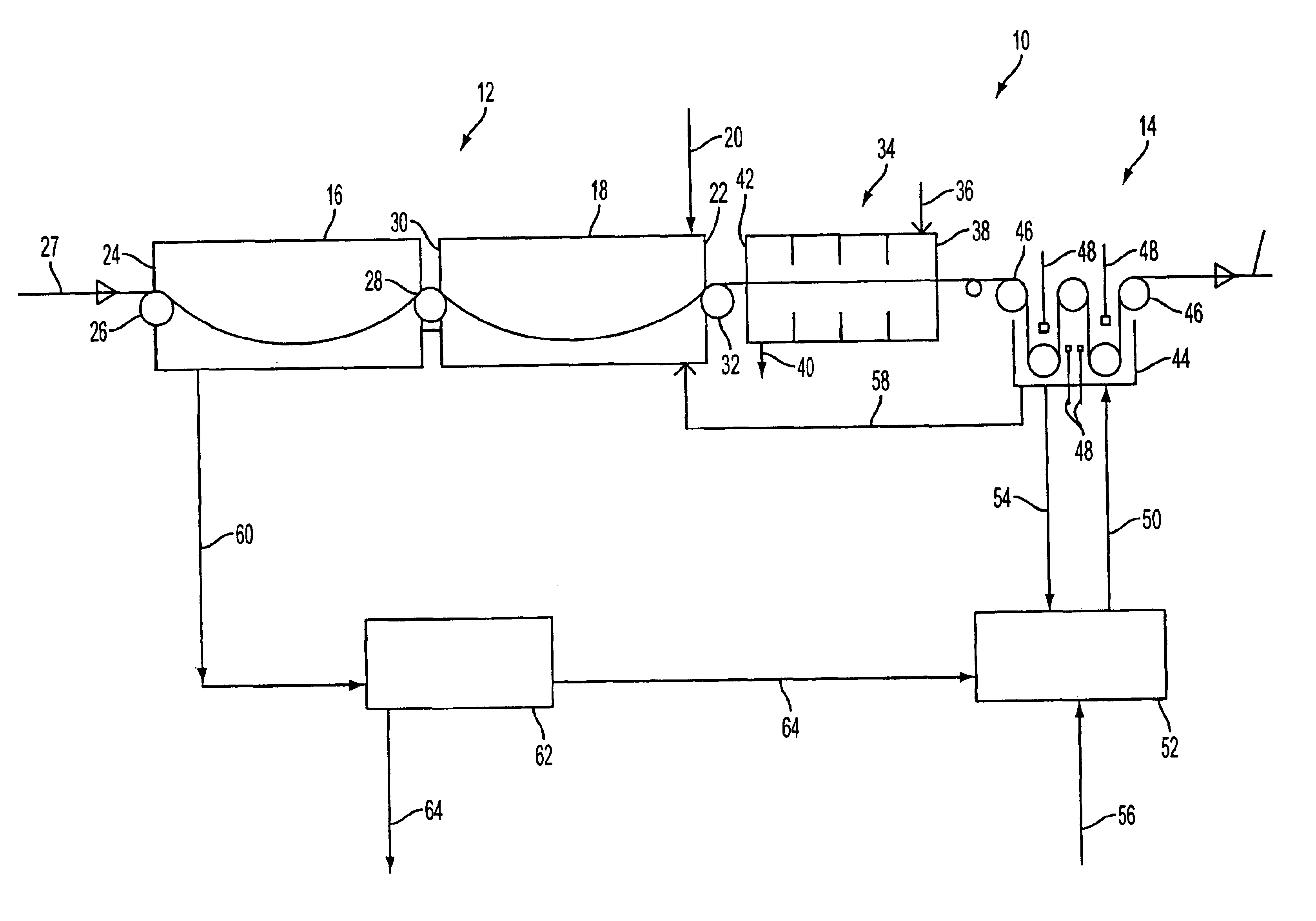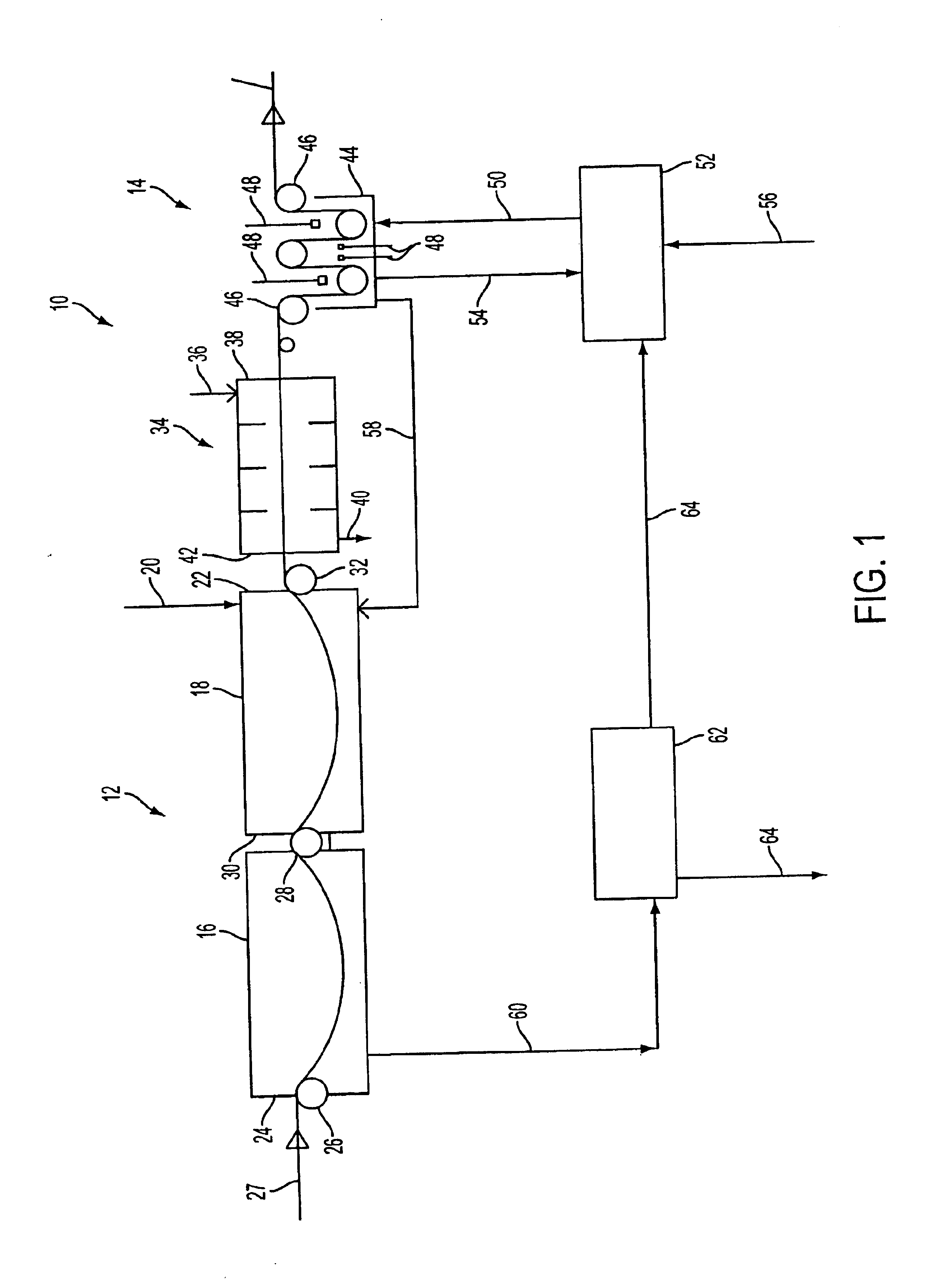Apparatus for electrically coating a hot-rolled steel substrate
- Summary
- Abstract
- Description
- Claims
- Application Information
AI Technical Summary
Benefits of technology
Problems solved by technology
Method used
Image
Examples
example 1
A sulfuric acid pickling solution containing 20% sulfuric acid at a temperature of 90° C. was supplied to the pickling tanks. A hot-rolled steel strip was fed to the inlet end of the pickling tank and carried through the sulfuric acid pickling solution and discharged through the outlet end of the pickling tank. The steel strip was rinsed briefly with water to remove residual pickling acid and iron sulfate on the steel strip. The steel strip was then carried directly to the electro-coating tank. Galvanic cells in the electro-coating tank were positioned in a vertical orientation and equipped with insoluble titanium anodes coated with iridium dioxide (IRO2). The cells contained a zinc sulfate electrolyte solution with a pH of 1.5 and a temperature of 55° C. Four anodes were positioned in the galvanic cells, with two anodes positioned on the upper and lower side of the steel strip. The anodes were supplied with a current of 300 amps. The steel strip was fed through the electro-coatings...
example 2
A hydrochloric acid pickling solution containing 16% hydrochloric acid at a temperature of 80° C. was supplied to the pickling tank. The hot-rolled steel strip was passed through the pickling tank and supplied directly to the electrolytic coating tank without prior rinsing. The galvanic cells in the electro-coating tank were fitted with soluble zinc anodes in the form of strips. The electrolyte solution was a zinc chloride solution with a pH of 3.0 and a soluble iron content of approximately 5 grams per liter. An electric current was supplied to the anodes and the steel strip to form a layer of pure zinc on the steel strip. The coating was analyzed as being substantially pure zinc which produced a bright finish. The surface produced in this example was brighter than the zinc coating produced from the zinc sulfate electrolyte solution of Example 1. The resulting coating was assessed as adhering very well to the steel strip. Metallo-graphic investigations also showed that the pickling...
example 3
In this example, a hydrochloric acid pickling solution containing 16% concentration hydrochloric acid and a temperature of 80° C. was supplied to the pickling tank. The hot-rolled steel strip was directed through the pickling acid and supplied directly to the electro-coating tank. The spent pickling acid was withdrawn from the pickling tank and pumped to a dissolving column containing granulated zinc. The spent pickling acid withdrawn from the pickling tank contained 100 grams per liter iron, 60 grams per liter HCl and total chlorides of 190 grams per liter. The spent pickling acid effectively consumed the granulated zinc and provided an electrolyte solution containing 100 grams per liter iron, 54 grams per liter zinc and total chlorides of 190 grams per liter. This electrolyte solution was then carried to the electro-coating tank. The electro-coating tank was fitted with insoluble anodes and a diaphragm. An electric current was supplied to the anodes and the steel strip to form a l...
PUM
| Property | Measurement | Unit |
|---|---|---|
| Current | aaaaa | aaaaa |
| Solution | aaaaa | aaaaa |
Abstract
Description
Claims
Application Information
 Login to View More
Login to View More - R&D
- Intellectual Property
- Life Sciences
- Materials
- Tech Scout
- Unparalleled Data Quality
- Higher Quality Content
- 60% Fewer Hallucinations
Browse by: Latest US Patents, China's latest patents, Technical Efficacy Thesaurus, Application Domain, Technology Topic, Popular Technical Reports.
© 2025 PatSnap. All rights reserved.Legal|Privacy policy|Modern Slavery Act Transparency Statement|Sitemap|About US| Contact US: help@patsnap.com


